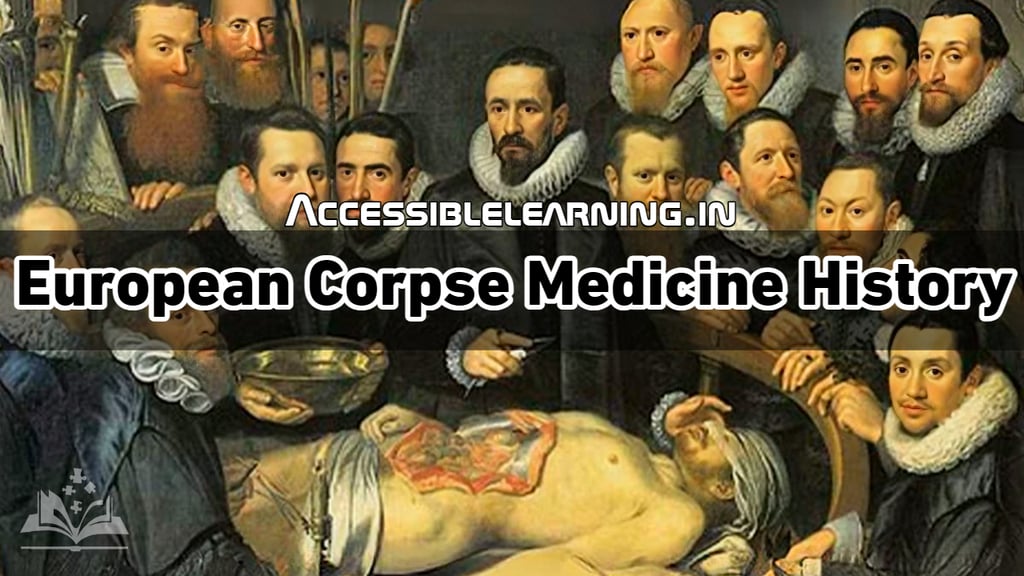
European Corpse Medicine: A Strange Chapter in Medical History
The history of European corpse medicine not only gives an eye-opening account into how far people are willing to go for health and healing, but also it serves a unique historical backdrop. It captures an era in which the... it reminds us of how far medical science has come.
SCIENCE/PHILOSOPHYHEALTH/DISEASEBIOGRAPHY/HISTORYEDUCATION/KNOWLEDGE
Kim Shin
8/30/20243 min read


As apple as history's European corpse powder is, the form of necrophagia long known by that name has an eerie and quixotic chapter in its annals. Practiced from the time of the Renaissance to the 18th century, it involved the use of human body parts in treatment procedures. It may be unsettling to modern conceptions, but at the time, it was considered an unremarkable, recognized, and respectable form of treatment. This article will explain the history of corpse medicine in Europe and how and why it was used, as well as its eventual end.
Origins and Practices
Ancient Roots
The practice of using human remains for medical purposes dates back to ancient civilizations. The Egyptians, for instance, were known to use mummy powder—ground-up mummified bodies—for various ailments. This concept was later adopted by Europeans and modified to fit their own medical theories and needs.
Renaissance to 18th Century
The practice of using human remains for medical purposes dates back to ancient civilizations. For example, the Egyptians used mummy powder—ground-up mummified bodies—for various ailments. The concept was later adopted by Europeans and modified to suit their own medical theories and needs.
Forms and Preparations
Mummy Powder: Mummy powder was believed to cure ailments such as internal bleeding, epilepsy, and bruises. The powder was often added to drinks or applied topically.
Human fat: Human fat was used to treat wounds, arthritis, and muscle pain. It was believed to have relaxing and healing properties.
Blood: Drinking fresh blood, often obtained from executed criminals, was believed to provide vitality and health. This practice was especially popular for treating epilepsy and other disorders.
Human skulls and bones: Powdered human bones and skulls were commonly used to treat headaches, epilepsy, and other ailments. It was believed that the essence of the deceased could infuse healing properties into the living.


Reasons Behind the Practice
Sympathetic Magic
The belief in sympathetic magic, where eating human body parts could transfer the essence or healing properties of the deceased to the living, was a driving force behind cadaveric therapy. The concept was based on the idea that like things affect like.
Religious and Superstitious Beliefs
Religious and superstitious beliefs played an important role in the acceptance of cadaveric therapy. The notion that the life force of the deceased could heal the living was linked to the spiritual and mystical beliefs of the time.
Lack of Medical Knowledge
In an era of limited medical understanding and the absence of effective treatments, people turned to all available options, including those that now seem bizarre. In the desperate search for health, cadaver therapy was seen as a viable option.
Notable Figures and References
Paracelsus
The Swiss physician and alchemist Paracelsus was a notable proponent of cadaveric therapy. He believed in the medicinal properties of the human body and incorporated them into his treatments, advocating the use of mummy powder and other human-derived substances.
King Charles II
King Charles II of England was known to drink the "King's Drops," a tincture made from human skulls. This practice highlighted the acceptability of cadaver medicine even among the highest levels of society.
John Donne and Francis Bacon
Prominent intellectuals and writers of the time, such as John Donne and Francis Bacon, referenced and sometimes supported the use of cadaveric therapy. Their writings provide insight into the widespread acceptance of the practice.


Decline and Criticism
Scientific Advancements
The rise of modern medical science and the development of more effective, scientifically supported treatments led to the decline of cadaver therapy. As medical knowledge advanced, the reliance on human remains for treatment decreased.
Ethical Concerns
Growing moral and ethical concerns about the use of the human body for medical treatment played a significant role in the decline of cadaver therapy. The practice was seen as horrific, distasteful, and derogatory to the deceased.
Cultural Shifts
Changing cultural and social attitudes towards death and the treatment of human remains also contributed to the gradual elimination of the practice. The emerging emphasis on human dignity and the sanctity of the body made cadaver medicine increasingly unacceptable.
The European use of corpse medicine is a fascinating chapter in the long history of human beings forsaking their moral compass in steering towards health and healing. It shows us a time when the lines between medicine, magic, and superstition were blurry indeed, and it should show how far medical science has gotten. This bizarre juncture in medicine may be a reminder of how far we have come and the fact that humans, as always, want to best nature.
European cadaver therapy is evidence of the complexities of historical medical practices and the interrelationships of culture, faith, and science. Although it may seem shocking today, it was once a respected and accepted form of treatment, providing insight into the constantly evolving nature of medical knowledge and ethics.
Subscribe to our newsletter
All © Copyright reserved by Accessible-Learning
| Terms & Conditions
Knowledge is power. Learn with Us. 📚


